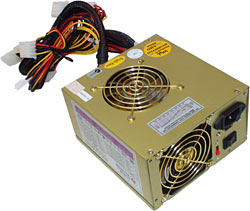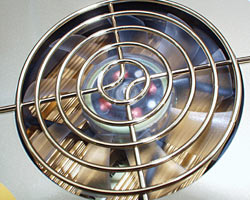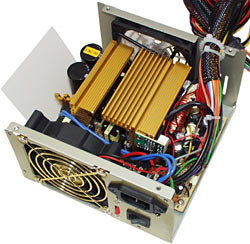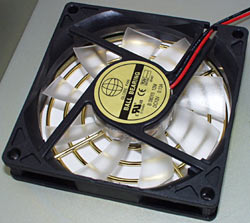
Super Flower 550 watt power supply
Review date: 10 May 2002. Last modified 03-Dec-2011.
There's a rule of thumb when buying computer gear that says "the sillier the brand name, the lousier the product". This isn't an inviolable law of nature, but it's a pretty good bet.
Lots of off-brand Chinese-made gear is perfectly all right, of course. But products made by Illuminated Dragonfish Manufacturing or Ultra Gold Yum Yum Corporation are, generally, less likely to be a great buy than those from some generically named outfit.
For this reason, I wasn't exactly boiling over with enthusiasm to review a Super Flower Power Supply Unit (PSU).
Enermax, sure. Topower, no problem. Super Flower? Please.
It turns out, however, that these three brands are... well, they're actually pretty much the same. I'm told that they're all made in the same factory in Guangzhou. The companies they're made for are different, but they're just OEMs, at least as far as their PSU business goes.
Enermax PSUs are pretty good units. High power ratings, OK reliability, groovy looks, decent price for what you get. A 550 watt Enermax, more than adequate for all but the most ludicrously stacked Power User systems, will set you back $AU297 delivered from Aus PC Market.
Topower PSUs are much the same, only cheaper. Unless you want some cosmetic feature that a Topower PSU doesn't have, there's not a lot of reason to buy a similarly specified Enermax instead. A 520 watt Topower is currently $AU214.50, delivered.
Super Flower PSUs are cheaper again. Aus PC Market carry two identical-looking Super Flower models, rated at 470 and 550 watts respectively. They're $AU203.50 and $AU225.50, delivered.
(Note - if you're searching for these PSUs on the Aus PC site, they're catalogue numbers CS-FP470 and CS-FP550, and they're currently listed under the Atlas brand, for some reason.)
I checked out the 550 watt Super Flower.
Never mind the power rating, for a moment. If you're just looking for a PSU to set off your neon-encrusted window-sided water-cooled show-off-case, this one's a winner.
Three, count 'em, three, fans. One full thickness 80mm exhaust fan at the back, two slimline 80mm intake fans on the front and the bottom panel (the PSU's upside-down in these pictures).
On top of the de rigeur vaguely gold-ish lacquered finish on the PSU box, and the shiny gold finger guards, all three fans have translucent impellers. So you can see the motor coils through the hubs of the intake fans.
OK, it's not as nifty as a TMD fan entirely made out of clear plastic, but it's still pretty cool.
There's a switch on the back panel of the PSU that lets you change the fan behaviour.
With the switch in the default position, all three fans are thermally controlled. When I powered the PSU up on the test bench in this mode it ran very quietly, because it was breathing cool air.
If one of the numerous stickers on the PSU is to be believed, you'll get less than 1000RPM at temperatures below 10 degrees Celsius, speeds between about 1000 and about 1500RPM between 20 and 30 degrees, and a peak speed of 2500RPM at 70 degrees.
If your computer's case ventilation isn't very bad, and your room temperature isn't high enough to make naturism more of a necessity than a choice, then the thermal sensor inside the PSU isn't likely to see 70 degree C air. You can still get full power out of the fans if you like, though; the back panel switch has two other settings, which give you medium or full power constantly, without thermal control.
With the fans at full power, this PSU shifts plenty of air - it'd be more than sufficient as the only ventilation source for most PCs.
With the lid off, this PSU bears a strong resemblance to its Enermax and Topower brethren. Big chunky gold-anodised heat sink for the power semiconductors, very similar circuit board, quite good manufacturing quality. Get past the bright colours and you can see that this thing hasn't been put together by zillion dollar Japanese robots, but the soldering seems fine, no wires are stretched, and nothing's rattling around.
This "550 watt" PSU's power ratings break down pretty well, though it's not quite as beefy as its overall rating suggests. There's 28 amps for the +3.3 volt rail and 55 amps for +5V; the combined rating limit for these two rails is 275 watts. The +12V rail has a separate 22 amp rating, for another 264 watts, but the total rating for all three main power rails put together is only 530W.
To get right up to the full sticker rating you've got to include the other rails - the +5V standby rail and the -12V and -5V rails account for another 27 watts between them. The 470 watt Super Flower supply similarly falls slightly short of its rated power, if you don't include the low current rails.
But 530W (or 450W, for the "470W" unit) is still more than good enough. There are darn few computers that'll overstress these PSUs.
Here's the bottom panel fan, viewed from the inside. The two intake fans only have 1.56 watt ratings (as with all PSU fans, they run from the 12 volt rail), but a lot of case fans aren't rated much higher. This PSU can move about as much air as a parallel pair of low power back panel exhaust fans.
Overall
You very probably don't need a PSU with more than 500 watt capacity. But there's no harm in having one. It won't draw any more power when running a modest PC than any other PSU would, and it gives you the security of knowing that everything's likely to be well within its operating limits. And these PSUs also look spiffy and have enough air-shifting power to be a useful part of your PC cooling solution.
Or, in thermally controlled mode, they'll keep the noise down unless your computer seems to need a lot of air movement.
The 550 watt Super Flower PSU is almost twice the price of a quality basic 300 watt supply, like the AOpen one that Aus PC sell for $AU115.50 delivered. The 470 watt Super Flower's not much cheaper. And most PCs need nothing more than the cheap AOpen can provide.
$110 extra isn't a huge margin in the computer hardware world, though, and these PSUs with silly names do seem to deliver, in all departments.
Recommended.
Super Flower's
site
(which contains no mention of these models, as I write this)
Buying it
Aus PC Market don't stock this PSU any more, but they've got
lots of others!







